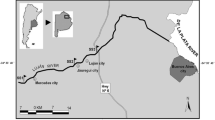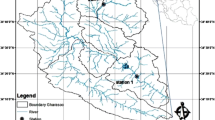Abstract
The Reconquista river is one of the most polluted watercourses in Argentina. More than 3 million people and over 10,000 industries are settled on its basin. The available data show that pollution is mainly related to the discharge of domestic and industrial liquid wastes that are poured into the river almost untreated. At present no site of the river can be characterized as free of pollutants. Samples were taken monthly from 5 sites of the river; some 18–20 physicochemical parameters were determined in each sample. Analyses revealed significant differences in the degree of deterioration between sites. Two of them, close to the source of the river (Cascallares-S1 and Paso del Rey-S2) resulted less polluted than the two points located close to the mouth of the river (San Martin-S4 and Bancalari-S5). The worsening of the water quality in S4–S5 was attributed to the discharges of the Moron stream, a tributary that flows into the main course of the river a complex mixture of non treated waste waters. PCA was used in the ordination of samples (sites, season and physicochemical parameters). In the PCA performed using all variables, the first principal component showed positive correlation with N-NH4 +, conductivity, orthophosphate, BOD5, COD and alkalinity, and negative correlation with DO. The second principal component was positively correlated with pH, temperature and chlorophyll a and negatively with phenols and hardness. In respect to the spatial distribution, the plot of the scores for the first two components of samples taken in each sampling station showed S1 and S2 values displayed farthest at the left side of the X axis with high DO. In contrast, S4 and S5 values stayed at the right side of this axis with high N-NH4 +, conductivity, orthophosphate, BOD5, COD and alkalinity; data of S3 were “intermediate". In order to identify seasonal trends in the concentration of contaminants scores of cases labeled by season were plotted. The line drawn on the ordination plane showed that summer samples tended to converge to the upper right portion of the graph where pollution variables had more importance on the first axis, and along the second axis with high correlation with pH, temperature and chlorophyll a. Winter scores were settled in the left lower part of the plot with minor contribution of pollution parameters and more importance of DO on the first axis. Samples of autumn and spring did not fit a clear cut pattern.
Similar content being viewed by others
References
A. P. H. A.: 1992, Standard Methods for the Examination of Water and Wastewater, 18th ed., APHA-AWWA-WPCF, Washington DC.
Alsina, M. G. and Herrero, A. C.: 2000, ‘Relevamiento de industrias en la cuenca del río Reconquista y georreferenciación de las de tercera categoría según nivel de complejidad ambiental (ley 11.429). Relación entre actividad industrial y grado de contaminación de la cuenca’, in: Actas Simposio Latinoamericano de Percepción Remota, November, Iguazú, Argentina, pp. 867–878.
Castañé, P. M., Topalián, M. L., Rovedatti, M. G. and Salibián, A.: 1998a, ‘Impact of human activities on the water quality of the Reconquista River (Buenos Aires, Argentina)’, Verh. Internat. Verein Limnol. 26, 1206–1208.
Castañé, P. M., Loez, C. R., Olguín, H., Puig, A., Rovedatti, M. G., Topalián, M. L. and Salibián, A.: 1998b, ‘Caracterización y variación espacial de parametros limnológicos de un río urbano contaminado (Río Reconquista, Argentina)’, Rev. Int. Contam. Ambient 14, 69–77.
Chapman, D. and Kimstach, V.: 1992, ‘The selection of water quality variables’, in: Chapman, D. (ed.), Water Quality Assessments. Chapman and Hall, London, pp. 51–120.
Clayton, J. W.: 1997, ‘The biology of the river Tweed’, Sci. Total Environ. 194/195, 155–162.
Kuczynski, D.: 1994, ‘Environmental study of an urban highly polluted watercourse (Morón stream, Buenos Aires, Argentina)’, J. Med. Ecol. Environ. Health 1, 1–14.
Legéndre, L. and Legéndre, P.: 1979, Ecologie numérique. Vol. I and II. Masson, Paris; les Presses de l'Université du Québec (Vol. I, pp. 197 Vol. II, pp. 254).
Loez, C. R. and Salibián, A.: 1990, ‘Premiéres données sur le phytoplancton et les caractéristiques physico-chimiques du río Reconquista (Buenos Aires, Argentine), une riviére urbaine polluée’, Rev. Hydrob. Trop. 23, 283–296.
Loez, C. R. and Topalián, M. L.: 1999, ‘Use of algae for monitoring rivers in Argentina with a special emphasis for the Reconquista river (region of Buenos Aires)’, in: Prygiel, J., Whitton, B. A. and Bukowska, J. (eds), Use of Algae for Monitoring Rivers III, Agence de l'Eau Artois-Pecardie, pp. 72–83 [ISBN 2-9502083-5-5].
Mc Carthy, L. H., Williams, T. G., Stephens, G. R., Peddle, J., Robertson, K. and Gregor, D. J.: 1997, ‘Baseline studies in the Slave River, NWT, 1990–1994: Part I. Evaluation of the chemical quality of water and suspended sediment from the Slave river (NWT)’, Sci. Total Environ. 197, 21–53.
Olguín, H. F., Puig, A., Loez, C. R., Salibián, A., Topalián, M. L., Castañé, P. M. and Rovedatti, M. G.: 2004, ‘An integration of water physicochemistry, algal bioassays, phytoplankton, and zooplancton for ecotoxicoclogical assessment in a highly polluted lowland river’, Water Air Soil Pollut. 155, 355–381.
Rovedatti, M. G., Loez, C. R., Topalián, M. L., Castañé, P. M., Salibián, A. and Olguín, H.: 2000, ‘Monitoring of a polluted river (Reconquista, Argentina) based on physicochemical parameters and phytoplancton’, Verh. Internat. Verein Limnol. 27, 2743–2748.
Rovedatti, M. G., Castañé, P. M., Topalián, M. L. and Salibián, A.: 2001, ‘Monitoring of organochlorine and organophosphorus pesticides in the water of the Reconquista river (Buenos Aires, Argentina)’, Wat. Res. 35, 3457–3461.
Salibián, A.: In press, ‘Ecotoxicological assessment of the highly polluted Reconquista river of Argentina’, Revs. Environ. Contam. Toxicol.
Topalián, M. L. and Castañé, P. M.: 2003, ‘Aplicación de índices químicos para la evaluación de la calidad del agua del río Reconquista’, in: Alsina, G., (ed.), Las aguas bajan turbias en la región metropolitana del Gran Buenos Aires, Ediciones Al Margen-Universidad Nacional de General Sarmiento, Argentina, pp. 69–83.
Topalián, M. L., Rovedatti, M. G., Castañé, P. M. and Salibián, A.: 1999a, ‘Pollution in a lowland river. A case study: The Reconquista river (Buenos Aires, Argentina)’, Water Air Soil Pollut. 114, 287–302.
Topalián, M. L., Castañé, P. M., Rovedatti, M. G. and Salibián, A.: 1999b, ‘Principal component analysis of dissolved heavy metals in water of the Reconquista river (Buenos Aires, Argentina)’, Bull. Environ. Contam. Toxicol. 64, 484–490.
Zalazar, R. H. (ed.): 1996, Cuencas Hídricas (Contaminación. Evaluación de riesgo y saneamiento). Inst. Prov. Medio Ambiente (Gob. Pcia. de Bs. As.), Buenos Aires, pp. 184.
Author information
Authors and Affiliations
Corresponding author
Additional information
Deceased
Rights and permissions
About this article
Cite this article
Castañé, P.M., Rovedatti, M.G., Topalián, M.L. et al. Spatial and Temporal Trends of Physicochemical Parameters in the Water of the Reconquista River (Buenos Aires, Argentina). Environ Monit Assess 117, 135–144 (2006). https://doi.org/10.1007/s10661-006-7980-z
Received:
Accepted:
Issue Date:
DOI: https://doi.org/10.1007/s10661-006-7980-z




